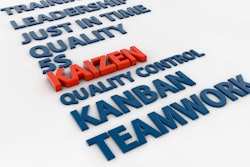Marty OsbornSenior Director, Enterprise Asset Management, Infor
In discrete manufacturing, the adoption of “lean” principles has become an increasingly important strategic practice for reducing waste and improving profits and efficiency. However, many companies do not have the right tools in place for addressing lean methodologies within preventive maintenance (PM) efforts.
Effective PM relies on enterprise asset management (EAM) systems, in which discrete manufacturers can proactively maintain equipment at peak running efficiency, preserving valuable and often specialized assets. EAM offers streamlined planning, actionable real-time information, and cost-effective spare parts management that enable lean principles to permeate the maintenance process and help employees in continuous improvement efforts.
Streamlined Planning
While most manufacturers with PM programs plan and schedule PM activities, the reality is that many of these are not as diligent as is necessary. The benchmark goal has been 90% for planned PM activities and 10% for corrective/breakdown maintenance. In reality, the ratio is often 30% planned maintenance to 70% unplanned. This contributes to waste and costs associated with equipment wear, lost productivity as maintenance personnel scramble to react, and potential customer service issues with delayed delivery times.
EAM enables discrete manufacturers to adhere to lean principles by further refining their PM activities. For example, it allows manufacturers to define assets in terms of size, type, and location, as well as tailor PM tasks to a specific asset. EAM’s ability to track and manage work requests, labor, planning, and scheduling allows companies to cut waste and improve productivity.
With easy access to detailed asset information, maintenance planners are better equipped to schedule tasks, plan routes, and estimate the materials required. For example, multiple assets that share similar requirements or are in close proximity may be combined in a single work order, relieving planners from the clutter of multiple work orders, cutting maintenance labor costs, and preserving uptime with proactive work.
Dashboards in EAM tools provide PM planners with an immediate view of key performance indicators (KPIs). These dashboards can be tailored, for example, to alert the planner that a critical PM task is overdue based on a certain KPI. The ability to quickly view scheduled tasks, combined with those on backlog, lets planners select the right activities to best optimize assets without wasting time sorting through thousands of work orders.
Effective PM relies on greater communication between line maintenance personnel, PM planners, and managers. With prioritized routes, planners can now take advantage of an unplanned shutdown to “save” a planned shutdown, improving overall productivity. Likewise, PM tasks can be scheduled to coincide with equipment changeovers and other planned shutdowns.
Real-time Data Improves Planning, Asset Life
A critical aspect of PM planning is the availability of real-time data. EAM tools utilize the real-time information from equipment control systems to allow scheduling of maintenance tasks based on metered usage, not just a fixed date or time period. For example, motor PM tasks might be scheduled on runtime hours or the number of starts and stops instead of at monthly intervals, letting companies determine the critical metrics for each piece of equipment.
Real-time information enables PM planners to set alarm limits for various aspects of an asset’s performance. If a tolerance for temperature or vibration, as an example, is exceeded, the EAM system can issue a work order for maintenance planners to consider, as well as trigger a gauge reading on a dashboard.
PM and Green Manufacturing
Though not often recognized, environmental performance is another important aspect of effective PM programs where EAM is helpful. Manufacturers want well-maintained equipment to preserve uptime and reduce replacement costs, but optimized energy consumption is an increasingly important side benefit as fuel and power costs skyrocket. For example, a motor might use 30% more energy than is necessary due to increased friction if a bearing is not properly maintained.
EAM has the ability to track energy usage against optimal performance. Real-time alarm limits can quickly alert PM planners where energy drain occurs so that preemptive action is taken. In addition to its importance in overall cost control, the ability to be a “green” friendly manufacturing facility is becoming increasingly important to customers and end-users and a way to gain competitive advantage.
Spare Parts Management
Efficient MRO inventory management offers discrete manufacturers a major opportunity to trim excess costs. In industrial facilities, most parts storerooms contain a substantial number of excess or obsolete parts. Often, these parts add up to a six- or seven-figure investment that taints the maintenance budget.
With EAM’s proactive maintenance planning regime, expensive “just-in-case” storeroom inventories are replaced by a “just-in-time” inventory that eliminates costs from overstocking without jeopardizing equipment uptime. Once storeroom managers reap benefits from inventories based on actual usage, they become more than willing to set and adhere to realistic inventory min-max levels. In fact, studies have shown that effective PM programs can reduce the number of parts on hand by 30-40%.
Also, with preventive maintenance planning facilitated by EAM, stores managers know in advance which parts are required for upcoming PM activities, allowing them to order ahead of time for lower shipping costs as opposed to reactively requiring a next-day delivery.
Storeroom management tools accurately monitor and control parts inventory and keep track of delivery times, vendor performance payments, receipts, issues, returns, and cycle counts. In addition, EAM tools can automate purchasing and many other inventory management functions, as well as enable manufacturers to better capitalize on supplier consolidation schemes to leverage parts prices.
EAM eliminates the guesswork from preventive maintenance. Understanding your maintenance requirements and using the right technology can enable manufacturers to implement a strategic plan for maintenance that increases asset utilization for a greater return on investment, ensures inventory levels are accurate, and even helps companies maintain plants that are environmentally friendly.




















